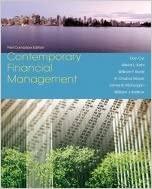Answered step by step
Verified Expert Solution
Question
1 Approved Answer
(Q1) (Q2) A variable-rate mortgage of $115,000 is amortized over 15 years by equal monthly payments. After 18 months the original interest rate of 8%
(Q1) (Q2)
(Q2)

A variable-rate mortgage of $115,000 is amortized over 15 years by equal monthly payments. After 18 months the original interest rate of 8% compounded semi-annually was raised to 8.3% compounded semi-annually. Two years after the mortgage was taken out, it was renewed at the request of the mortgagor at a fixed rate of 8.1% compounded semi-annually for a four-year term. (a) Calculate the mortgage balance after 18 months. (b) Compute the size of the new monthly payment at the 8.3% rate of interest. (c) Determine the mortgage balance at the end of the four-year term. (a) The mortgage balance is $ after 18 months. (Round the final answer to the nearest cent as needed. Round all intermediate values to six decimal places as needed.) (b) The size of the new monthly payment is $ (Round the final answer to the nearest cent as needed. Round all intermediate values to six decimal places as needed.) (c) The mortgage balance is $ (Round the final answer to the nearest cent as needed. Round all intermediate values to six decimal places as needed.) A mortgage balance of $26,000 is to be repaid over a 12 -year term by equal monthly payments at 6.9% compounded semi-annually. At the request of the mortgagor, the monthly payments were set at $450. (a) How many payments will the mortgagor have to make? (b) What is the size of the last payment? (c) Determine the difference between the total amount required to amortize the mortgage with the contractual monthly payments rounded to the nearest cent and the total actual amount paid. (a) The mortgagor will have to make payments. (Round up to the nearest whole number.) (b) The size of the last payment will be $ (Round the final answer to the nearest cent as needed. Round all intermediate values to six decimal places as needed.) (c) The difference is $. (Round the final answer to the nearest cent as needed. Round all intermediate values to six decimal places as needed.)
Step by Step Solution
There are 3 Steps involved in it
Step: 1

Get Instant Access to Expert-Tailored Solutions
See step-by-step solutions with expert insights and AI powered tools for academic success
Step: 2

Step: 3

Ace Your Homework with AI
Get the answers you need in no time with our AI-driven, step-by-step assistance
Get Started


